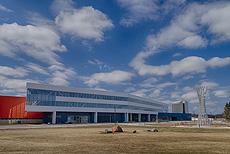IARC construction prepares buildings for 2015 occupancy
 |
Now that the IARC Office, Technical and Education Building has received beneficial occupancy, Fermilab can begin outfitting the interior. Photo: Reidar Hahn
|
Fermilab teams are hard at work preparing the spaces that will foster accelerator innovation and collaboration with private industry partners. Those spaces compose the Illinois Accelerator Research Center, which should be up and running by this time next year.
The center's two buildings, the Heavy Assembly Building (HAB) and the Office, Technical and Education Building, are still in various stages of construction.
The OTE building was funded by a grant from the State of Illinois Department of Commerce and Economic Opportunity. Fermilab recently reached a major milestone when it received beneficial occupancy, which means that OTE was turned over by the construction subcontractor Barton Malow to Fermilab. This allowed completion of the terms of the state grant, and the Facilities Engineering Services Section can now begin outfitting the building's interior.
Near future work, under the supervision of IARC OTE Project Manager Rhonda Merchut, will consist of partitioning the space into offices, installing computer networks and voice-over-internet equipment, and installing card readers for intellectual property control. Since the networks are installed underneath the OTE's raised floors and the interior is still under construction, the building remains locked, and there is no public access.
"The Office, Technical and Education Building holds office space for private industry to use in the short term to collaborate with our scientists and engineers," Merchut said.
Once IARC is fully operational, access to the OTE and the HAB will be limited because of the nature of the work done there. Merchut expects that the OTE will be dedicated and occupied by the spring of 2015.
Work on the HAB is transforming the space formerly used by the CDF collaboration into an area that can best support the IARC mission. The building is undergoing life safety upgrades, such as pressurizing stairs and replacing fire detection systems to bring the building up to the current code standards. The high-bay area (the space with the big crane), which will be used to put together accelerators for industrial use, will get new ventilation systems, crane controls, refurbished electrical and cooling infrastructure, lights, and paint. A portion of the exterior of the building will also be updated. Crews will install new wall panels and south-facing windows around the office support bay.
"We're trying to make it a more pleasant and energy-efficient space," said FESS's Steve Dixon, who is heading the refurbishment of the HAB.
In parallel to the construction, the IARC management team, led by IARC Director Bob Kephart, is working to complete a business model that would allow the laboratory to more efficiently interact with private companies.
"There is already a lot of interest from industry to do business with us," said IARC General Manager Charlie Cooper. Some of the areas of interest include accelerators applications for energy and environment, accelerator-driven industrial chemistry, and reactor-free creation of medical isotopes.
Cooper is looking forward to the industry partnerships that IARC will foster. He believes these partnerships will have a significant impact on the local area and the laboratory.
"IARC is a way for the importance of Fermilab to become more recognizable to the taxpayer and a way for the laboratory to capitalize on one of its strengths," he said.
—Rhianna Wisniewski
|